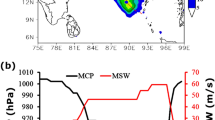Abstract
This study focuses on the sensitivity of tropical cyclones (TCs) simulations to physics parametrization scheme for TCs in the Bay of Bengal (BOB). The goal of this study was to arrive at the optimum set of schemes for the BOB region to increase forecast skill. Four TCs, namely Khaimuk, Laila, Jal and Thane have been simulated through the weather research and forecasting (WRF) model with all the physics parametrization schemes available in WRF, and the optimum set of schemes is arrived at. The analysis shows the cumulus, microphysics and planetary boundary layer parameterizations exert a very significant influence on the TC simulations than land surface, short-wave radiation and long-wave radiation parameterizations. With this optimum set of physics schemes, the impact of assimilation of National Centers for Environmental Prediction Automatic Data Processing upper air observations data in the TC simulations has been studied by using three-dimensional variational (3DVAR) data assimilation technique. The control run (without assimilation) and the 3DVAR-simulated tracks and maximum sustained wind speed have been compared with the Joint Typhoon Warning Center observed tracks and wind data. The model-simulated precipitation is validated with Tropical Rainfall Measuring Mission 2A12 surface rain rate and 3B42 daily accumulated rain data. Bias score and equitable threat score have been evaluated for both instantaneous rain rate and 72-h accumulated rain.











Similar content being viewed by others
References
Barker D, Huang W, Guo Y, Bourgeois A, Xiao Q (2004) A three-dimensional variational data assimilation system for MM5: implementation and initial results. Mon Weather Rev 132(4):897–914
Chandrasekar R, Balaji C (2012) Sensitivity of tropical cyclone Jal simulations to physics parameterizations. J Earth Syst Sci 121(4):923–946
Deshpande M, Pattnaik S, Salvekar P (2010) Impact of physical parameterization schemes on numerical simulation of super cyclone Gonu. Nat Hazards 55(2):211–231
Gandin LS, Murphy AH (1992) Equitable skill scores for categorical forecasts. Mon Weather Rev 120(2):361–370
Osuri KK, Mohanty U, Routray A, Kulkarni MA, Mohapatra M (2012) Customization of wrf-arw model with physical parameterization schemes for the simulation of tropical cyclones over North Indian Ocean. Nat Hazards 63(3):1337–1359
Osuri KK, Mohanty U, Routray A, Mohapatra M (2012) The impact of satellite-derived wind data assimilation on track, intensity and structure of tropical cyclones over the North Indian Ocean. Int J Remote Sens 33(5):1627–1652
Parrish DF, Derber JC (1992) The national meteorological center’s spectral statistical-interpolation analysis system. Mon Weather Rev 120(8):1747–1763
Raju P, Potty J, Mohanty U (2011) Sensitivity of physical parameterizations on prediction of tropical cyclone Nargis over the Bay of Bengal using WRF model. Meteorol Atmos Phys 113(3–4):125–137
Rao D, Prasad D (2007) Sensitivity of tropical cyclone intensification to boundary layer and convective processes. Nat Hazards 41(3):429–445
Singh R, Kishtawal C, Pal P, Joshi P (2011) Assimilation of the multisatellite data into the wrf model for track and intensity simulation of the Indian ocean tropical cyclones. Meteorol Atmos Phys 111(3–4):103–119
Singh R, Pal P, Kishtawal C, Joshi P (2008) The impact of variational assimilation of SSM/I and quikscat satellite observations on the numerical simulation of Indian ocean tropical cyclones. Weather Forecast 23(3):460–476
Skamarock W (2008) A description of the Advanced Research WRF version 3. NCAR Tech. Note NCAR/TN-475+STR
Skamarock W, Klemp J (2008) A time-split nonhydrostatic atmospheric model for weather research and forecasting applications. J Comput Phys 227(7):3465–3485
Srinivas CV, Venkatesan R, Bhaskar Rao DV, Hari Prasad D (2007) Numerical simulation of Andhra severe cyclone (2003): model sensitivity to the boundary layer and convection parameterization. Pure Appl Geophys 164(8–9):1465–1487
Srinivas CV, Yesubabu V, Hari Prasad K, Venkatraman B, Ramakrishna S (2012) Numerical simulation of cyclonic storms fanoos, nargis with assimilation of conventional and satellite observations using 3DVAR. Nat Hazards 63(2):867–889
Srinivas CV, Bhaskar Rao DV, Yesubabu V, Baskaran R, Venkatraman B (2013) Tropical cyclone predictions over the Bay of Bengal using the high-resolution Advanced Research Weather Research and Forecasting (ARW) model. Q J R Meteorol Soc 139(676):1810–1825
Author information
Authors and Affiliations
Corresponding author
Rights and permissions
About this article
Cite this article
Chandrasekar, R., Balaji, C. Impact of physics parameterization and 3DVAR data assimilation on prediction of tropical cyclones in the Bay of Bengal region. Nat Hazards 80, 223–247 (2016). https://doi.org/10.1007/s11069-015-1966-5
Received:
Accepted:
Published:
Issue Date:
DOI: https://doi.org/10.1007/s11069-015-1966-5




